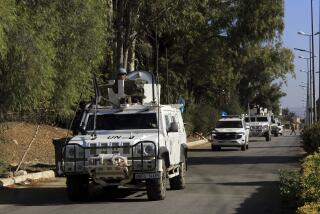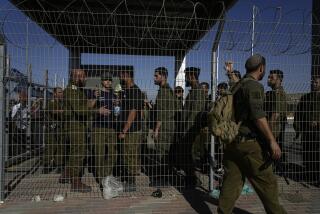U.N. Says Probe of Israeli Troops’ Capture Bungled
UNITED NATIONS — The U.N. conceded Friday that it mishandled videotapes and reports related to the October kidnapping of three Israeli soldiers, after denying for months that the tapes existed and failing to pass on information that the soldiers might have been fatally injured.
The kidnappers, members of the Islamic militant movement Hezbollah, apparently posed as U.N. peacekeepers to lure the Israeli soldiers into vehicles that had fake U.N. license plates and contained real U.N. uniforms, berets and insignia. That led to charges that peacekeepers had collaborated with the guerrillas.
But a special investigation commissioned by Secretary-General Kofi Annan after Israeli complaints that the U.N. was withholding information concluded in a report released Friday that there was no collusion and that “the mistakes made followed from lapses in judgment and failures in communication, not from conspiracies.”
Those failures only complicate the world body’s precarious relationship with Israel. On Friday, Israeli diplomats expressed “discomfort” at the U.N.’s treatment of Hezbollah--which the Jewish state considers a terrorist group--as an equal to U.N. member Israel. The Israeli government also regards the incident as an illustration of the ineffectiveness of the international peacekeepers in the U.N. Interim Force in Lebanon, or UNIFIL.
“If we have to draw a lesson from this report, it showed that UNIFIL . . . was totally ineffective and inefficient in dealing with even a small group of Hezbollah terrorists,” said Israel’s U.N. ambassador, Yehuda Lancry. “We . . . remain opposed to such observers.”
And not only can the U.N. not protect Israeli citizens, Israeli officials have said, but it also hasn’t been doing much to help Israel in this incident. Trying to maintain the world body’s neutrality in the Hezbollah-Israeli conflict, Annan has offered to share with Israel the videotapes showing Hezbollah guerrillas only if their faces are obscured.
For weeks, the Israeli government has insisted on the unedited version or nothing, but on Friday it accepted Annan’s offer. Israel also will send forensic experts to the U.N. early next week to conduct DNA tests on blood-spattered items recovered from the cars apparently used by the abductors.
In a telephone conversation with Annan on Friday, Israeli Foreign Minister Shimon Peres said, he accepted the report’s findings and thanked Annan for his cooperation.
“This affair is a top priority of Israel and is of great moral importance to Israel, the abducted soldiers and their families,” Peres said. “As an act of humanitarian importance, Israel asks that the families be allowed to view the videotapes.”
A U.N. spokesman did not say whether U.N. officials would be disciplined over the affair, but he said that the world body will “tighten up procedures to ensure that lapses in the chain of command do not occur again.”
The investigation’s report reconstructs the kidnapping and pinpoints the areas where U.N. procedures broke down.
Just after dawn Oct. 7, Hezbollah launched a well-planned abduction of Israeli soldiers near the Israel-Lebanon border, the report says. Guerrillas used more than 300 rounds of mortars and rockets in an attack on an Israeli outpost, enabling them to divert nearby U.N. peacekeepers and capture the three soldiers. Later that day, peacekeepers found two abandoned cars apparently used in the kidnapping, containing U.N. paraphernalia and large bloodstains.
UNIFIL’s deputy force commander, Gen. Ganesan Athmanathan of India, wrote in a report that the quantity of blood suggested that the occupants “may have been badly injured and may succumb to their injuries.” But that assessment was never passed on to his superiors in New York or to the Israeli government, which asked repeatedly for all information about the condition of its soldiers.
A day later, while peacekeepers were towing the vehicles, a small band of Hezbollah guerrillas forced them at gunpoint to hand over the cars. A U.N. soldier who had been documenting the condition of the cars’ interiors captured the guerrillas’ faces on videotape.
The commander of the peacekeeping force, Gen. Seth Kofi Obeng of Ghana, later decided that the tape shed no light on the condition of the kidnapped soldiers and that sharing it with Israel would be tantamount to providing military intelligence about one side to the other. Top officials in U.N. headquarters didn’t learn of the tape’s existence until late June or July, the report says, and so were truthful in earlier denials to Israel that they had additional information.
The report also notes the existence of two other videotapes that were not shared with Israel. One was a film of the shelling during the Oct. 7 kidnapping, taken by an unidentified person in or near the U.N. peacekeepers’ shelter, that did not show the abduction itself.
The other was Syrian television footage, which aired July 16, of Hezbollah reclaiming its cars from peacekeepers at gunpoint.
More to Read
Sign up for Essential California
The most important California stories and recommendations in your inbox every morning.
You may occasionally receive promotional content from the Los Angeles Times.










